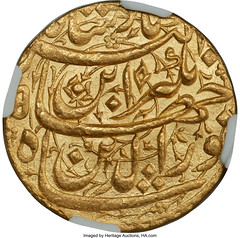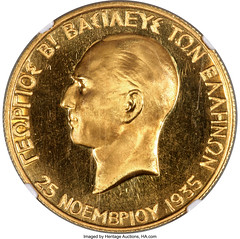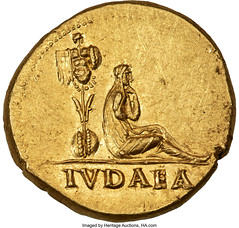
PREV ARTICLE
NEXT ARTICLE
FULL ISSUE
PREV FULL ISSUE
HERITAGE ANA WORLD & ANCIENT SELECTIONSIn a Heritage email dated August 2, 2024, catalogers offered their pick in their upcoming ANA World & Ancient Coin auctions. We agree! Nice coins -Editor
KYLE'S PICKS One of the most fascinating issues within the auction, both historically and aesthetically, is the Elizabethan 8 Testerns, certified MS61 by NGC. This instantly recognizable yet fleeting series was struck for just about a year in response to the rising influence of Spain overseas. While the defeat of the Spanish Armada by Elizabeth and her cunning navy cemented England as a rising global superpower, Spain would continue to dominate trade in the new world. To combat this, the 1, 2, 4, and 8 Testerns were minted, a clear rival to the Spanish Reales system. While ultimately failing to take hold, these "Portcullis" types remain among Great Britain's most iconic and sought-after monetary relics. To see the largest denomination as well as the finest known is no small feat, and we're proud to present such an example.
To read the complete item description, see:
Large German gold issues aren't particularly difficult to find in our auctions, but I do take particular interest in both allegorical types and city views, both of which are represented in this choice mint state Portugalöser of Hamburg. Struck in celebration of the cessation of hostilities between Denmark and Hamburg, the piece features personifications of Goodness and Faithfulness embracing, slightly reminiscent of contemporary marriage medals, while a fine rendering of Hamburg decorates the reverse, with a maritime scene in the foreground. Altogether rare, and the only example witnessed by NGC, surely becoming a top lot for the German States specialist.
To read the complete item description, see:


India: Mughal Empire. Jahangir (AH 1014-1037 / AD 1605-1627) gold Heavy (Sawai) Mohur AH 1019 Year 5 (1609) MS62 NGC Among my favorite types we are beginning to handle with greater regularity are Mughal Mohurs, especially those of Jahangir. While the calligraphy on these expansive gold types is always appreciable, the floral or foliate elements to both faces sets these apart from other contemporary gold types. When witnessed at near-choice mint state, the fields glisten, highlighting those features further, and becoming a work of art.
To read the complete item description, see:
MAKAR'S PICKS This attractively styled prize coin celebrates the fifth anniversary of the restoration of the monarchy in 1940. With a mintage of only 140 and even fewer certified examples, it stands out for collectors and remains a key piece in the Greek series, appearing at auction perhaps only once or twice annually on average. Its vibrant history includes significant world events and the life of George II. He acceded to the Greek throne but was exiled to Romania in October 1923 after a failed royalist coup. He resumed his royal duties in 1935 following a rigged referendum. His reign spanned from September 1922 until March 1924, and again from November 25, 1935 until his death in April 1947. The unique history of his return to power and his rule through World War II makes this coin a collectible masterpiece. It is one of, if not the, most recognizable and contested issues of Greek numismatics from the 20th century.
To read the complete item description, see:
This coin is always found in beautiful color and stunning design. It is one of the most desirable pieces of "modern" Japanese coins, marking the first year of production for a new monetary system based on the Yen and utilizing presses from the Hong Kong mint. The Meiji era (1868-1912) was the first half of the Empire of Japan, during which the entire country transitioned to a modern, industrialized nation-state, adopting Western scientific, technological, philosophical, political, legal, and aesthetic ideas. This period marked the transition from the Edo period to the Meiji era in politics and society. Very rare and desired worldwide, the number of certified coins indicates its scarcity and popularity. It is one of the masterpieces that initiated Japan's new monetary system.
To read the complete item description, see:
ERIC'S PICKS It is always a joyous numismatic occasion when conditions align perfectly and a conditional outlier of an already scarce issue creates a coin of titanic significance. This one-year type is the inaugural date for both the Leu denomination and silver coinage issued by Romania as an independent nation. It also contains a "C" privy mark on the reverse, which is not a mint mark, but an initial for Candescu, the chief engineer of the State Mint of Bucharest; an occurrence that would cease after 1870. As we can see, this coin has many admirable qualities that have contributed to its popularity as an integral piece of Romanian numismatic history. This present specimen is likely the finest example still in existence, easily besting an NGC MS66 for the title of "Top Pop" among those certified by the most trusted of American Third Party Grading companies. We would not be surprised to see a bidding war of epic proportions when this miraculous Superb Gem specimen crosses the auction block along with the rest of the Romanian treasures from the Carpathian Collection.
To read the complete item description, see:
A visually captivating type that is of striking similarity to the Caesar coinage to which this issue clearly pays homage to. Though not the rarest of types, with auction appearances on a yearly basis being somewhat numerous worldwide, this splendid design provides a clear lineage from Roman coinage to Medieval Continental coinage and the slightly more advanced minting processes. This historical linkage resonates with collectors and increases the emission's desirability, appealing to enthusiasts of both Ancient and Medieval numismatic persuasion. This Choice Mint State example will provide a fortunate collector the opportunity to own an excellent representative of this storied type that would be one of the more unique looking coins in any collection.
To read the complete item description, see:
ZACH'S PICKS 

Ancients: SICILY. Syracuse. Deinomenid Tyranny, Hieron I (ca. 475-470 BC). AR tetradrachm (24mm, 17.45 gm, 7h). NGC Choice XF Star 5/5 - 5/5 Although I didn't handle many Greek coins when I was a dealer before coming to Heritage, I've seen many Syracusan types and denominations during my time here, and this early tetradrachm type has grown on me. There's something about holding a beefy ancient silver coin, and this particular one has so much going for it - excellent centering, beautiful style, and rainbow toning. It's exactly the kind of coin that draws your attention and makes you want to pick it up to admire all the details.
To read the complete item description, see:
Wow, where do I even begin with this one? The portrait style and meticulous details are off the chart, especially compared to the companion aureus minted in Rome. This Spanish mint issue is gorgeous and quite rare, with only a small handful known. Then, there is the historical aspect of the coin, hailing from Vespasian's campaign against Judaea and the resulting Judaea Capta issues. I'm certain this will be one of the most active lots in the ancients part of the auction, and it will be a centerpiece for the fortunate high-bidder.
To read the complete item description, see:


Ancients: Gordian III (AD 238-244). AE medallion (37mm, 47.83 gm, 11h). NGC Choice VF 4/5 - 3/5, Fine Style One question I often get is, "How did you get started collecting ancient coins?" I was on holiday with my mom and sister in Italy in the 1990s when I went into a coin store in Rome and discovered ancient coins. I bought a Gordian III antoninianus, which I still have in my collection, and because of that start, Gordian III will always have a place in my heart. On that trip, of course, we visited a ton of ancient sites, including the Colosseum. If you haven't seen it yourself, you really should go. It's unbelievable to experience. The rare types depicting this architectural marvel are always sought after. Fun fact - sometimes, there are reenactors there in various Roman military regalia, and one challenged me to arm wrestling. Not fun fact - I lost. I still had a great time, though!
To read the complete item description, see:
MADISEN'S PICKS 

Ancients: MACEDON. Chalcidian League. Ca. 432-348 BC. AR tetradrachm (27mm, 14.46 gm, 1h). NGC AU Star 4/5 - 4/5, Fine Style, light marks This session has some stunning coins, but something about this stater's restrained, ethereal beauty stands out to me. The artistry is exceptional, and the subtle silhouette toning highlights the idealistic portrait of Apollo. Receiving both the Star and Fine Style designations, this is definitely a coin that should be appreciated in hand.
To read the complete item description, see:


Ancients: Nero, as Augustus (AD 54-68). AE sestertius (36mm, 31.60 gm, 5h). NGC Choice AU 4/5 - 2/5, Fine Style A sharp turn from the simplicity of the tetradrachm, this Port of Ostia Sestertius features detailed and complex design choices. The Fine Style devices are remarkable; it's incredible how much the engraver included on such a small canvas. Commemorative architectural types are always popular with collectors, and I expect this one will be a favorite of the session.
To read the complete item description, see:


Ancients: Faustina Junior (AD 147-175/6). AV aureus (20mm, 7.19 gm, 5h). NGC AU 5/5 - 4/5, Fine Style Completing my picks with another simplistic type, I really enjoy the softness of this aureus; the portrait is youthful, the surfaces are satiny, and even Venus' drapery seems to pool around her in a pleasing way. It strikes a delightful balance between intricacy and restraint, resulting in a coin that overall feels quite feminine and elegant.
To read the complete item description, see:
Wayne Homren, Editor The Numismatic Bibliomania Society is a non-profit organization promoting numismatic literature. See our web site at coinbooks.org. To submit items for publication in The E-Sylum, write to the Editor at this address: whomren@gmail.com To subscribe go to: https://my.binhost.com/lists/listinfo/esylum All Rights Reserved. NBS Home Page Contact the NBS webmaster 
|













